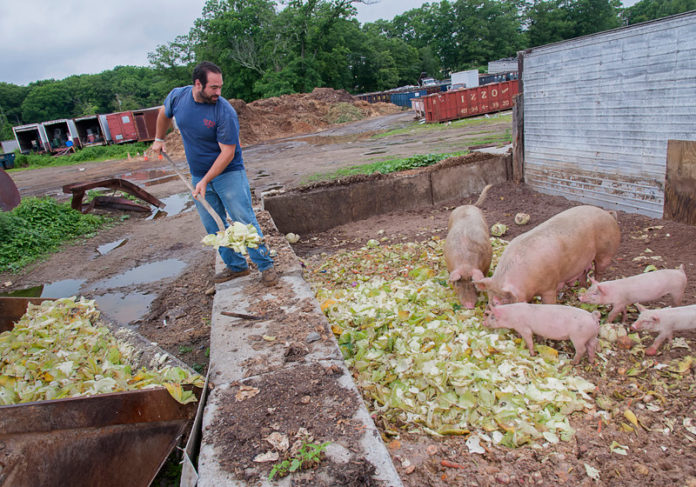
Rhode Island’s only landfill, in Johnston, is on track to be filled by 2038. The big question facing the state is: Then what?
While it is obviously not the complete answer, diverting food scraps from schools, restaurants, food- processing plants, resorts, prisons, hospitals and other large institutions is one action supported by state lawmakers that could help slow the rising tide of trash at the state’s Central Landfill.
The General Assembly last week was expected to give final approval to legislation that would require large producers of food scraps to have the organic waste composted or processed by an anaerobic digesting facility if there’s one within 15 miles or to use the scraps for agriculture. Anaerobic digesters don’t use oxygen from the air, compared to composting, which does.
The legislation, which needs Gov. Lincoln D. Chafee’s approval, is a step in the right direction, said Michael OConnell, executive director of the R.I. Resource Recovery Corporation, which operates the landfill.
“The idea of the legislation is to keep the organic waste out of the landfill and we’d all love to do that, but there’s no infrastructure to make it happen,” said OConnell. “It depends on how much organic waste would get diverted from the landfill to digesters – which don’t exist.”
Rhode Island only has one commercial-scale composting site, in Charlestown, that takes food scraps. A company called NEO Energy is working to establish an anaerobic digestion facility in Quonset Business Park in North Kingstown.
Johnson & Wales University has been using an anaerobic digester at its culinary school for more than a year. “I’ve been to see the digester at Johnson & Wales,” said OConnell. “It can do 750 pounds a day, not even one-half of one ton. The process has value, but it’s not scaled up.”
Organic waste probably makes up about 15 percent of the landfill content, although the specific breakdown of waste products won’t be known until a current study in progress is completed, said OConnell.
In theory, if about a dozen digesters were immediately available and 15 percent of the waste was diverted for 25 years, the capacity of the landfill would be extended by about four years, estimated OConnell.
“Ultimately, in the long run, food digesters are going to be the next big thing,” said OConnell. “I just think it’s going to take a while to get there. If you don’t have the infrastructure, it’s going to cost the user more, and if it costs more, they won’t be inclined to recycle.
“This legislation is really intended for the industrial food-waste industry, and my unscientific guess is that residential is the biggest portion of food waste,” said OConnell. “People go out to restaurants once in a while, but everybody eats at home all the time.”
One place where people are preparing food much of the time is at Johnson & Wales’ College of Culinary Arts. So the culinary school was an obvious place for a pilot program, said Tim O’Connor, the university’s director of environmental health and safety.
“It was clear when I came here two years ago that it was already a topic ripe for discussion,” said O’Connor. “We had someone who was focused on managing waste to make our process more efficient,” he said. In addition, a student had written a paper about trying to do more with the school’s food waste.
“It’s a popular topic because we’re training chefs,” said O’Connor.
The first anaerobic digester arrived in March 2013 and a second one was added that fall, O’Connor said. Both were at the Harborside campus where the culinary school is located. The pilot program didn’t include the school’s dining facilities at other locations.
One of the machines was at a loading dock and couldn’t be vented properly, especially during the coldest winter weather, so it was sent back, said O’Connor.
The machines were designed by Biogreen360, a company in Stratham, N.H.
The digester unit costs about $75,000 and the school has it on a lease-to-own program that goes over four years, said OConnell.
“When I did my original financial analysis, we’d get a return on investment in about eight years,” said O’Connor.
The digester has gotten a very positive response from students and faculty, he said.
“Every year before the academic session starts, our culinary senior management puts the professors and chefs through a training session. When we rolled out the digester program at that session, they applauded. It was kind of awesome,” said O’Connor.
“There’s also a very high level of interest from the students. They really seem to grasp the importance of environmental issues,” said O’Connor. “I’ve had kids stop me in the hallway and ask me about the digester program.”
The school personalized the machine with a naming contest. The winning student was Yaileen Colon-Milan who offered the name Chewbacca, said Johnson & Wales spokeswoman Lisa Pelosi.
“The students nicknamed it Chewy,” said Pelosi.
With the quiet summer months, Chewy is in New Hampshire for preventative maintenance.
The pilot program totaled a few months, with vacation breaks and one digester being sent back.
“In that time, we diverted about 82 tons of food scraps,” said O’Connor. The food waste from the two culinary buildings is about 400 tons per year, he said. The culinary program generates about half of the food waste of the entire campus.
When the second digester was discontinued in February, Johnson & Wales began giving food scraps from one culinary building to farmer Carlo Izzo, of Izzo Brothers Farm in Johnston, who believes the proposed legislation is a good idea.
“I think it’s good for the farmers and it’s good that it saves space in the landfill,” said Izzo, a third-generation farmer who currently has 90 pigs, in addition to cows, on the 40-acre farm founded by relatives.
“This is the way they used to do it, they recycled,” said Izzo, who uses the food scraps he picks up at Johnson & Wales to feed the pigs.
“It saves us having to buy some of the feed for the pigs, but in the long run, it costs us time,” said Izzo. “If the food we receive is previously cooked, we can feed it to the pigs, but if there’s anything raw, like meat or fish that can contaminate it, we have to cook it all. We boil it in a big vat.”
Even though recycling the food scraps takes more time, Izzo favors the proposed change.
“I like the idea that it helps the farmers and I live up the road from the landfill,” said Izzo. “I think it’s good that everyone does what they can to cut down on the trash that goes into the landfill.”












